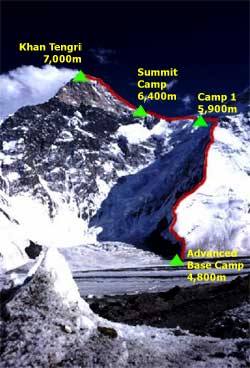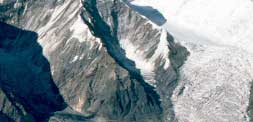Where in the world is Kazakhstan?
This was the most common question asked of us when we made plans to climb in the Central Tienshan Range of Kazakhstan.
Kazakstan is a large, independent country and was formerly one of the Soviet Union’s Central Asian Republics.
From July 22 to August 26, 2000, members of the Singapore – Latin American Everest Expedition 2001 will be training in this area as part of the pre-Everest preparations. They will also be training and instructing 5 younger climbers from Singapore who have been groomed under the CLIMB 2000 programme run by the Mountaineering Society of Singapore. This programme trains future climbers and leaders as part of the effort to develop mountaineering in Singapore.
Together, the 8 member team will conduct climbs on the Bayankol Peaks. Attempts will be made on Bayankol and Karlytoo Peaks, both in the 5,000 to 6000m range. Following this, the 3 member Everest 2001 members will make an attempt on Khan Tengri, 7,000m, a difficult and cold mountain opposite from the Bayankol Peaks.
Despatches from Kazakhstan
4 August 2000
Message from Kazakhstan
All well here at Inylchek base camp. Morale is good. The team has acclimatized and will be leaving for Karlytau peak today. We’ll do 6 days of training and climbing. Hoping to summit on August 6.
Khan Tengri route is icy and avalanches have been coming off the mountains.
Weather here good in the mornings. Low clouds and snow in the afternoon and evenings. First snow fall was about 10cm.
With regards,
David Lim & Singapore Tien Shan Team
22 August 2000
Just a little frost nip!
E2001 team backin Almaty safe except for alittle frost nip on one of Rozani’s fingers. No serious attempt was made on Khan Tengri in the latter stages of the expedition owing to too much snow. We made an attempt on Bayankol Peak Aug 13-15 but a second round of deep snow scratched that climb as well. We got close to Karly Tau’s corniced summit and then elected to stop at that point. Putting more weight on a summit which is essentially a huge cornice was not our idea of a smart move.
Altogether. about 1.5 m of snow fell in the last 10 days of our expedition
The seriousness was underlined by the death of a German climber on the route 2 weeks ago. He fell from between C1 and C2 while on the fixed ropes.
Nevertheless we are inspired by the tremendous Russian climbers we have met including members of a successful North face KhanTengri team and of the 1997 Makalu West Face team.
Back in Singapore Aug 25th
Regards,
Dave, Beng Cheong and Roz
Tien Shan Range
July 22nd marks the departure of the CLIMB 2000 Foundation Team for Kazakhstan. The team was been selected over 2 Selection Weekends in 1999 and have since received instruction and mentoring in their alpine climbing quest.
This marks the first time any mountaineering expedition from Singapore is attempting peaks in the Tien Shan range. The Team will be given instruction by members of the Everest 2001 team, making the event a joint effort. Weather and health permitting, 2 – 3 peaks will be attempted. Subsequent to the Foundation Team’s programme, The Everest team will remain to attempt Khan Tengri ( 7000m ) a difficult and technical peak in the same range.
The Khan Tengri Massif
“Travelers passing the Khan-tengri from either side, are struck by its tremendous size, plentitude of snow… but all of them seem to be content with viewing this colossus from a distance and do not risk approaching it.”
Russian geologist Mushketova
 The snow and ice massif of the Khan-tengri rises on the border of Kirghizia and the Sinkiang-Uighur Autonomous Province of China. It is one of the most beautiful heights in the world–Nature herself has moulded these majestic forms out of the original chaos. Above these ranges, in a gap, towers the glistening pyramid of the Khan-tengri, which looks like a hand-made sculpture of exceptional beauty rising high into the bottomless sky.
The snow and ice massif of the Khan-tengri rises on the border of Kirghizia and the Sinkiang-Uighur Autonomous Province of China. It is one of the most beautiful heights in the world–Nature herself has moulded these majestic forms out of the original chaos. Above these ranges, in a gap, towers the glistening pyramid of the Khan-tengri, which looks like a hand-made sculpture of exceptional beauty rising high into the bottomless sky.
“Travelers passing the Khan-tengri from either side,” wrote the well-known Russian geologist Mushketov, “are struck by its tremendous size, plentitude of snow, etc., but all of them seem to be content with viewing this colossus from a distance and do not risk approaching it.”
A quarter of a century after Gotfried Merzbacher’s 1902 attempt to reach the Lord of the Spirits, a small reconnaissance group–organized by the Ukrainian Association of Orientalists, the People’s Commissariat of Education and the Supreme Council of Physical Culture of the then young Soviet Republic, reached the foot of the Khan-tengri.
In those days the Tien Shan Mountains were dangerous not only because of their avalanches and rock cascades, but also because of the Basmatch bands of counter-revolutionary bandits.
That, however, did not deter M. Pogrebetsky and his companions who, after several recces and attempts, scaled the marble peak on Sep 11, 1931. Since then, numerous routes have been added to the peak, some extremely difficult. Many people have died attempting Khan Tengri, including the famed Russian climber Valerie Khrischaty [sic] from an icefall.
The distant mountains of Kazkhastan reverberates for a brief moment… with the sweet snores of Roz…
 Comfortably snugged in my sleeping bag, I was trying to get some sleep after a long summit day which saw us waking up at 2 am in the morning to do an alpine style start for the summit. Wondered whether my tent mates, Roz and Hairul, had fallen asleep or were they also just lying there wondering.
Comfortably snugged in my sleeping bag, I was trying to get some sleep after a long summit day which saw us waking up at 2 am in the morning to do an alpine style start for the summit. Wondered whether my tent mates, Roz and Hairul, had fallen asleep or were they also just lying there wondering.
However, when the familiar snoring sound broke the serenity of the mountain, I knew that I had once again lost in the race to fall asleep first. It was going to be more difficult to fall asleep having to put up with the snoring.
We were into Day 16 of our Tien Shan expedition and the next day we would be moving back to Khan Tengri Base Camp. We had just come down from a summit attempt on Karlytoo, a 5450 m peak, some 12 hours ago. We were about 100 m away from the summit when we were forced to turn back as the summit was sitting on a precariously overhanging cornice. I guessed this is what mountaineering is all about, sometimes it does not matter whether you summit or not, but it is the journey to the mountain from the beginning to the end that completes the objective. Being able to summit is just a bonus to the whole thing.
When we arrived at Karkara Base Camp 12 days ago, we went through a 3-day acclimatisation trek at the surrounding mountains before we were air-lifted to Khan Tengri Base Camp which was at about 4000 m. As part of the Climb 2000 programme’ to equip the Foundation Team members with basic alpine skills, we spent the next few days at Khan Tengri Base Camp where we were taught basic mountaineering skills by our mentors. Climbing Karlytoo was to give us a complete experience of what technical mountaineering was all about.
However, getting up the mountain was not the only part to the whole picture. In fact, for some, that would be the easy part. The real work would start from getting the team together, selecting the members, co-ordinating training schedules, juggling work commitments, sponsor hunting for some, getting the logistic together and not to mention the amount of sacrifices, in term of both time and money, each team member had to put in to pull off the expedition. For us, all this requires almost a year if not more of commitment and constant motivation.
All in all, I must say that Climb 2000 has given me a very complete experience of what mountaineering is all about. Different people from different background and environment come together with a common objective, to climb and experience mountaineering. At the end of it, it was more than that, it was a journey of learning, acceptance and self discovery.
Daniel
Climbing Schedule:
| 22nd July | Depart SIN TK 1035 @2220hrs duration 14hrs |
| 23rd July | Arrive Istanbul @ 0720hrs dep Almaty @1715hs duration 5:20hrs |
| 25th July | Transfer to BC Karkara (2200m) – 5,6 hours |
| 26th July | Acclimatization days, treks/ascents up to 4500m |
| 30th July | Helicopter flight (35-40 min) to BC Northern Inylchek (4000m) |
| 31st July – 1st Aug | Rest at Base Camp, glacier exploration, Ice axe technique, crevasse rescue and glacier walking |
| 2nd Aug | Carry to Bayankol, Camp 1 and return |
| 4th Aug – 6th Aug | Base Camp to Camp 1, Camp1 =Acclimatization Day exercises in snow arrest, cramponing, Camp 1 to summit ( 5791m ) to Camp 1 |
| 9th Aug | Move camp to Karlytoo |
| 10th Aug | Summit Karlytoo 5450m, to Camp 1 |
| 11th Aug | Camp1 Karlytoo/Bayankol to Base Camp Inylchek, prepare for Khan Tengri |
| 13th Aug | Base Camp Northern to Camp 1 ( 4900m ) on Pik Chapaeva, return to Base Camp |
| 14th Aug | Carry to Camp 1 |
| 15th Aug | Carry to Camp 2 ( 5900m ) |
| 17th Aug | to Camp 3 ( bivvi at 6400m ) |
| 19th Aug | Camp 3 to Khan Tengri summit, 7000m |
| 20th Aug – 21st Aug | Camp 3 to Camp 1, Camp 1 to Base Camp |

Leave a Reply